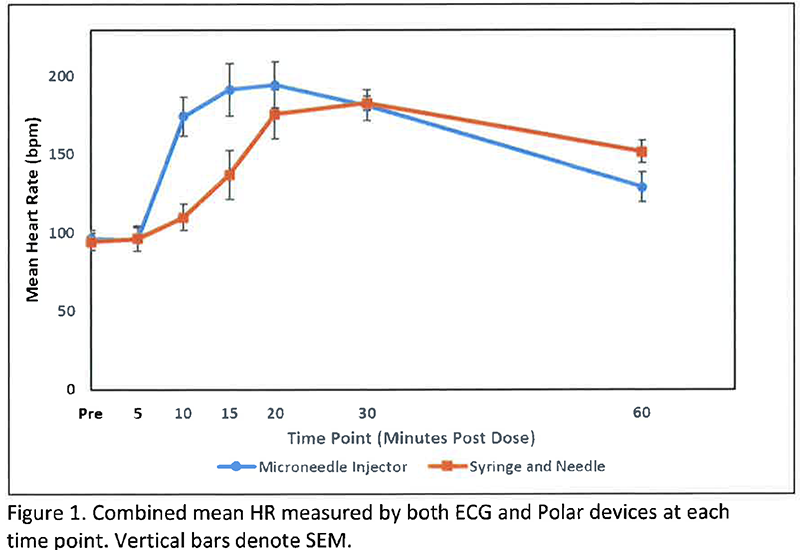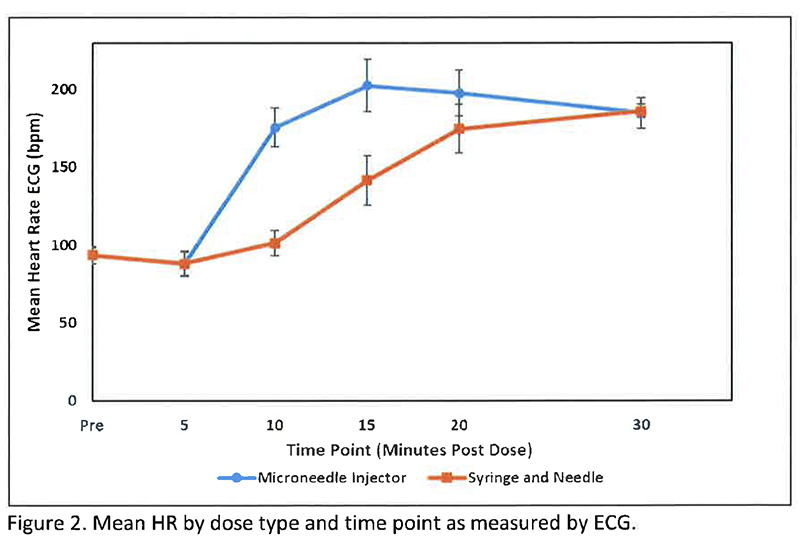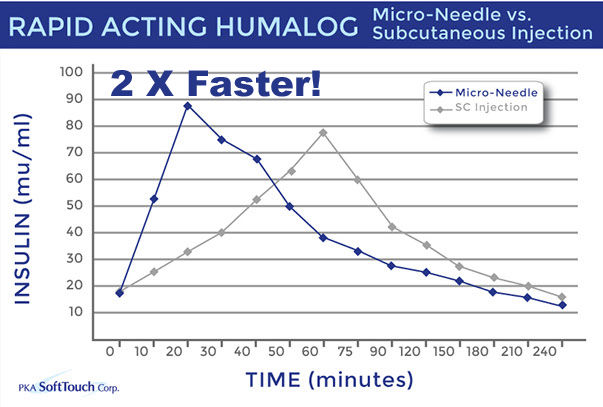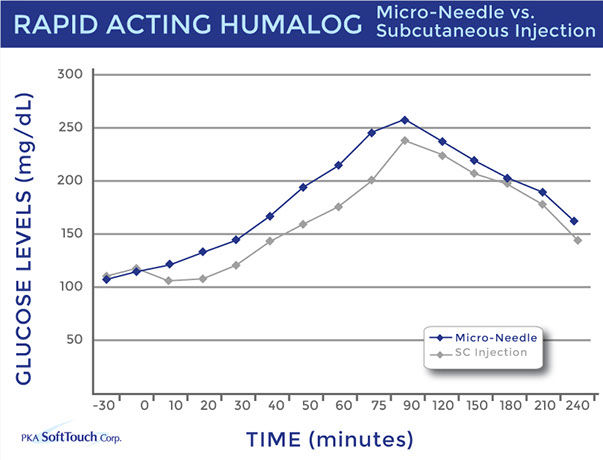*Day 0 subjects were administered a pre-prepared atropine dosing solution (~0.05 mg/kg) according to treatment order assignment (i.e., n=5 by Micro-Needle injection and n=5 by standard needle/syringe). Heart rate monitoring prior to dosing and continuously for 60 minutes post-dose. Also, periodic HR measurements prior to dosing as well as 5, 10, 15, 20, and 30-minutes post dose (±1 minute). Approximately 48 hours (±30 minutes) following the first dose, administration methods were crossed over and procedures repeated as described above.
Clinical Data for the PKA Micro-Needle Technology
CLINICAL TRIAL TEST RESULTS (2022)
COMPARISON OF PKA MICRO-NEEDLE DEVICE AND SUBCUTANEOUS INJECTION
Objective:
To evaluate the performance of a Micro-Needle injector device for intra-dermal (ID) administration of atropine compared to subcutaneous (SC) administration using a standard needle and syringe. Atropine was chosen due to its acute, fast-acting, and easily measurable effects.
Study Design:
Open Label, Randomized, Cross Over, Comparative Study 2022
10 Beagle Dogs received two treatments in a cross over fashion on separate days
- Standard Needle and Syringe*
- PKA Micro-Needle Device*
Below: Comparison Insulin Injection vs. Micro-Needle (Insulin Levels (uU/mL).


TEST RESULTS & CONCLUSION
✔ Absorption of atropine through the intra-dermal route was significantly faster when compared to subcutaneously injected atropine
✔ The earlier onset of action was statistically significant as noted at 10 minute, 15 minute, and 20 minute time points
✔ Attributed to more rapid absorption of atropine through intra-dermal interstitial fluid with PKA Micro-Needle injection
✔ No pain with the PKA Micro-Needle injection; The dogs responded well to the Micro-Needle injections and did not express any signs of pain at the time of dosing.
Clinical Data for the PKA Micro-Needle Technology
HUMAN CLINICAL TRIAL TEST RESULTS (2004)
COMPARISON OF PKA MICRO-NEEDLE DEVICE AND SUBCUTANEOUS INJECTION
Objective:
To compare the efficiency of PKA Micro-Needle based intra-dermal & epidermal drug delivery system with subcutaneous injection dose of human insulin after a standard breakfast meal in subjects with Type-1 Diabetes. We used Ely-Lilly’s Rapid Acting Humalog insulin drug.
Study Design:
Open Label, Randomized, Cross Over, Comparative Study 2004
(20 male or female volunteers with Type-1 Diabetes)
Patients received two treatments in a randomized fashion on separate days:
1. Insulin Injection*
2. PKA Micro-Needle Device*
*Each with (Humalog, Lilly) 7 units at time 0 minutes. All subjects to consume 360 calories (Boost or Ensure Plus Liquid Meals) 10 minutes after dose. Blood samples for plasma glucose and insulin taken 30 minutes before liquid meal and after (15, 30, 60, 90, 120, 180, 240, 300 minutes)
Below: Comparison Insulin Injection vs. Micro-Needle (Insulin Levels (uU/mL)


TEST RESULTS & CONCLUSION
✔ Absorption of insulin through the intra-dermal route was significantly faster when compared to subcutaneously injected rapid acting insulin (humalog)
✔ 30 mins & 60 mins postprandial glucose level rapidly lowered with PKA Micro-needle device vs. Subcutaneous injected group
✔ Humalog peaked approximately 50% faster with 30 mins of intra-dermal injection (Tmax=30mins)
✔ Attributed to more rapid absorption of insulin through intra-dermal interstitial fluid with PKA Micro-Needle injection
✔ No pain with the PKA Micro-Needle injection; patients never felt the pricking pain that is associated with the subcutaneous injection

